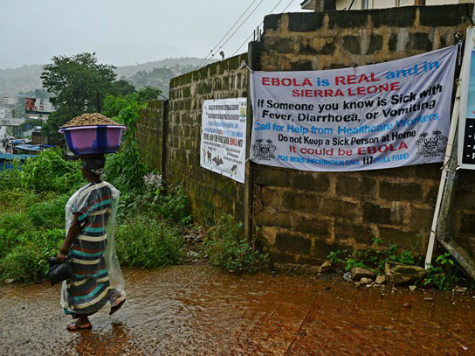With the World Health Organization announcing that the number of Ebola cases globally has neared the 2,000 mark AND the death toll nearing half of that, the government of Sierra Leone is implementing a centuries-old tactic to keep villages contaminated with the virus quarantined from the rest of the country.
ABC News reports that the government is now using the “cordon sanitaire” to keep individuals affected away from more densely populated areas that have steered clear of the virus. The tactic closes off affected areas, passing food and water through a small sanctioned area so as to not starve out the residents, but keeps all individuals within the cordon sanitaire from leaving the area.
The traditional cordons used in Europe functioned to close off areas affected by the bubonic plague, and, as the New York Times notes, could leave those within the cordon to die of starvation. “They have the potential to become brutal and inhumane,” writes the newspaper. “Centuries ago, in their most extreme form, everyone within the boundaries was left to die or survive, until the outbreak ended.”
The most recent large-scale use of the cordon, according to the New York Times, was in 1918 and used to keep typhus from spreading out of Russia.
Experts say that, while drastic, the cordon sanitaire method may work to keep Ebola out of untainted areas. Writing for The New Republic, Laurie Garrett describes the use of cordons in 1995 to stop the then-current Ebola outbreak. The isolation, she writes, “was brutally successful, as all trade to the Kikwit region ground to a halt, the desperately poor people were fully isolated to war with Ebola on their own, and few outsiders were able to find ancient military aircraft willing to fly to the town, landing on its ‘runway,’ a weedy soccer field.” Were such cordons used earlier, she argues, “we probably would not now be facing an epidemic that threatens to spread in the most populous nation on the African continent, Nigeria.”
Sierra Leone had begun to quarantine villages with a large number of Ebola cases this month, as the number of recorded cases grew exponentially. Sierra Leone, Liberia, and Guinea are the three nations hardest-hit by Ebola; Nigeria has recorded ten cases so far, while the United States is currently treating two, and Spain lost one man, a priest, to Ebola.
Liberia had initially taken the opposite approach to Sierra Leone, protecting its capital, Monrovia, rather than closing down avenues between affected villages. Individuals attempting to enter Monrovia that are coming from Ebola affected areas will not be let in. Though the virus has ravaged the capital, the Liberian government hopes to shelter the metropolis from a complete pandemic. The virus has spread throughout some towns so pervasively, however, that Liberia has followed Sierra Leone’s lead and blocked them off.
The effects of cordoning off a town can be devastating. The New York Times reports that one town in Sierra Leone, Njala Ngiema, has lost dozens and become quiet as those who wish to flee no longer can.

COMMENTS
Please let us know if you're having issues with commenting.